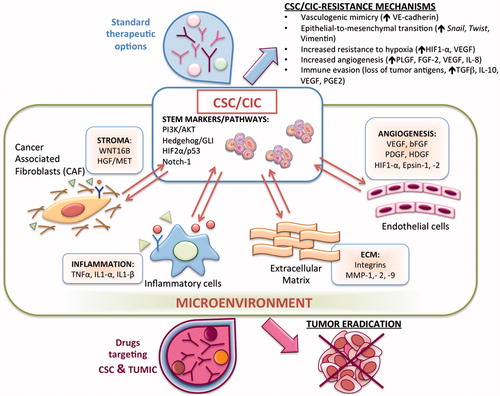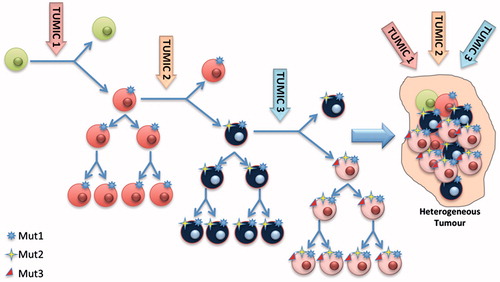Figures & data
Figure 1. Cancer Stem Cells or Cancer Initiating Cells (CSC/CIC) interact with the surrounding tumor microenvironment (TUMIC) by activating stem cell- and self renewal-associated pathways, such as Notch-1, PI3 Kinase and Hedgehog. Canonical anti-proliferative therapies mainly target bulk tumor cells, sparing aggressive CSC/CIC that are responsible for disease recurrence by activating resistance mechanisms including Vasculogenic Mimicry and Epithelial to Mesenchymal Transition. In addition, these cells may be able to: (1) survive hypoxia by increasing the production HIF1-α, VEGF; (2) increase angiogenesis by producing higher amount of pro-angiogenic factors; (3) induce immuno-tolerance by producing anti-inflammatory cytokines. Novel therapeutic treatments targeting both the CSC/CIC compartment and the TUMIC with the potential to eradicate the tumor, minimizing the risk of disease recurrence, are warranted.

Figure 2. Mutated cells might be able to survive specific microenvironmental conditions, while the tumor microenvironments (TUMICs) perform clonal selection by releasing peculiar growth factors and cytokines. TUMIC1 may select transformed cells harboring only Mut1. The evolving microenvironment in which tumor cells live (TUMIC2) may induce a second favorable mutation, Mut2. Only cells harboring both Mut1 and 2 will survive and generate daughter cells through symmetric division. Finally, a third mutation (Mut3) induced by TUMIC3 will generate more aggressive cells harboring Mut1, Mut2 and Mut3. The process of clonal selection gives rise to tumor heterogeneity.

